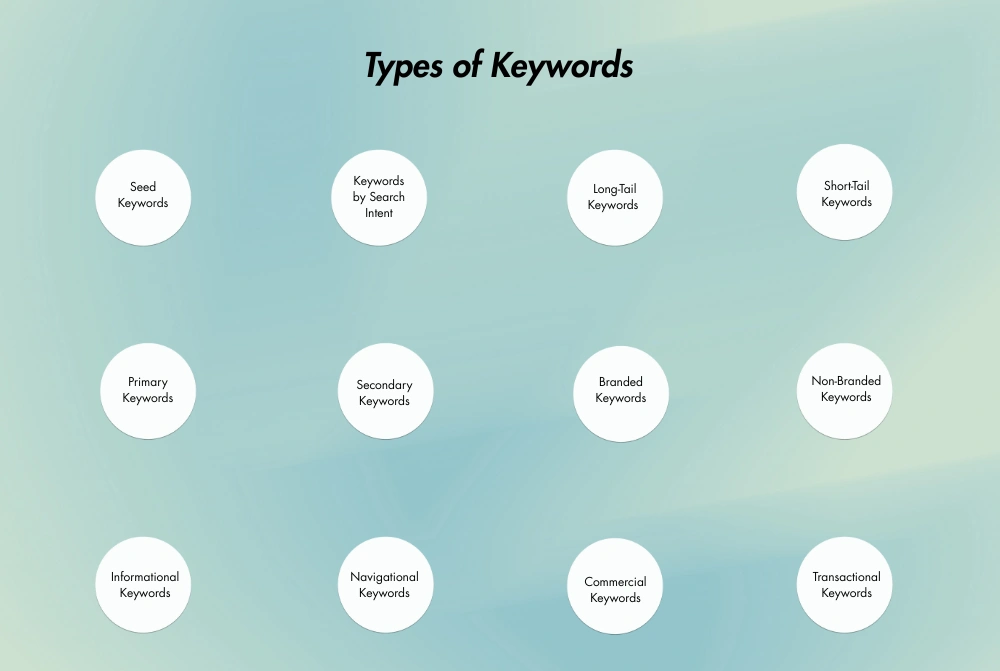TL;DR
Keywords are crucial for SEO, driving relevant traffic and improving search rankings. Using the right keywords, such as primary, secondary, and long-tail, helps target user intent. Key metrics like search volume, conversion rate, and keyword difficulty guide the SEO strategy. Implementing keywords naturally enhances content, improving visibility and long-term results.
A keyword is the phrase or idea that we enter into search engines to get related information. A keyword is also known as a search query that helps search engines show the desired result to a user. For instance, an “SEO agency” is a keyword that will show you the most relevant information about SEO agencies in your region. A keyword in the content is selected based on various parameters like competition, intent, volume, and more. Let’s learn everything there is to know about keywords in SEO.
The Importance of Keywords in SEO
SEO is the short form for Search Engine Optimisation. It is a process of optimising or improving the content of a web page to get more online visibility and a higher rank on SERPs.
When the content is optimised around the relevant keywords or phrases, the website has better chances of ranking higher on search engine result pages.
Keyword research is the foundational step in any SEO campaign, guiding the strategy and content planning for maximum visibility. It provides a roadmap to optimise the content around relevant phrases or words that a user might use in the search bar.
Keywords determine how users will find your website through search engines like Google. According to Google Search Central, when the content has the same keywords as the search query, it is the most basic indication that the information is relevant.
Basic Keyword Metrics That You Should Know
Here are some basic keyword metrics that a creative agency uses for making data-centric decisions in SEO:
-
Search Volume: Search volume is the average number of searches for a particular keyword over a given period of time.
-
Keyword Difficulty: Keyword difficulty indicates how tough it is to get a rank on Google for a specific keyword.
-
Cost-per-click: CPC is basically used in paid advertising. It shows the amount that advertisers pay for each click on their ad for a particular keyword.
-
Search Trend: Search trend helps in analysing the demand or popularity of a certain keyword over a particular timeframe.
What Are The Types of Keywords in SEO?
Seed keywords are the starting point of any SEO keyword research. These are the words or phrases that help you find other related keywords. For example, SEO is a seed keyword in “SEO agency”; similarly, AC is a seed keyword in “AC repair service near me”.
Keywords by Search Intent
Keywords by search intent are divided into four categories that reflect the intent or purpose behind a search query.
-
Informational Keywords: These are the keywords used by the people who want to educate themselves about the topic, for example: “what is SEO”
-
Navigational Keywords: Navigational keywords are the phrases or words that lead a user to a specific website or a webpage, for example: “Facebook login”.
-
Commercial Keywords: Commercial keywords lead the user to a specific product or service, for example: “best protein powder brand” or “compare protein powder prices”.
-
Transactional Keywords: These are the keywords that have the strongest intent to buy or take a certain action, for example: “buy protein powder” or “order men's shoes online”.
The multi-word phrases that are a combination of several words are called long-tail keywords. These are targeted to a highly specific audience or topic. These keywords have lower search volume and are thus less competitive. Example: “best AC repair service near me”.
Short-tail keywords are those search queries that typically consist of one or two words. These are the general search terms that most people use. For example: “creative agency” or “running shoes”.
Primary keywords are the words that focus on the main topic of the content. These are generally the broader terms with high search volume that represent the primary subject of your content. For example: “digital marketing” or “stock market”.
Secondary keywords are the detailed phrases or words that support the primary keyword in the content. These types of keywords help the users with specific search intents. For example: “digital marketing tips for startups” or “stock market trends 2025”.
Branded keywords include the name of a specific brand or product. These keywords target the audience who is already aware of a particular brand. For example: “Decathlon shoes” or “Sony Alpha 6100”.
The non-branded keywords are the search queries that do not include a specific brand name. These types of keywords are highly competitive. For example: “running shoes” or “digital camera”.
How to Effectively Use Keywords for Better Ranking
Here’s how you can strategically use keywords to get a better ranking on search engines:
-
Prioritise key areas: Use the primary keywords in the most impactful sections of the content, such as the title tag, meta description, URL, and H2 headings.
-
Natural integration: Naturally include the keywords in the content. Here’s how to do it:
-
Add the primary keyword in the first 100 words along with one or two secondary keywords.
-
Use secondary and long-tail keywords in subheadings.
-
Seamlessly distribute the primary and secondary keywords throughout the content.
-
Answer the questions: Focus on answering the user queries directly. You can use the long-tail keywords as questions in subheadings or the first sentences of paragraphs.
-
Use synonyms or LSI keywords: Use the synonyms or semantically related words of your primary keywords to avoid overstuffing of keywords.
-
Focus on readability: Make the content reader-focused. Emphasising only keywords leads to an unnatural tone that may lose the reader mid-content.
-
Keyword density: Focus on natural usage of keywords. Maintaining a keyword density between 0.5 and 2.5% is generally recommended.
-
Match keywords with intent: Always keep the user intent in focus. If your content successfully addresses the user's query, content is considered right.
Takeaway
Whether you’re crafting content for a blog or working on an SEO strategy for a brand, knowing the types of keywords and how to implement them will give you a solid foundation for success. Keywords are not just about getting traffic—they’re about attracting the right audience and addressing their needs. By mastering the art of keyword research and application, you’ll be one step closer to optimising content that drives both visibility and results.
Frequently Asked Questions
SEO keywords significantly boost the online ranking of the webpage and help users find the most useful and relevant information for their queries.
The best way to find popular keywords in a niche is competitor analysis. You can also use tools such as keyword planner or semrush for in-depth keyword research.
There are several types of keywords based on various factors. The intent-based keywords are: Informational, Navigational, Commercial, and Transactional. Other than these, SEO keywords are also divided into primary and secondary categories.
SEO keywords help in reaching the target audience, allowing marketers to convert website visitors into customers.
While Google does not prescribe a certain density for SEO, many SEO experts suggest maintaining a keyword density of 0.5% to 2.5%.










